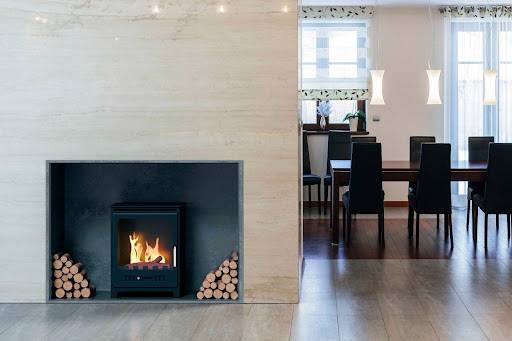
10 Creative Fireplace Hearth Ideas to Embellish Your Living Room

10% off on our Bioethanol Fireplaces. Subscribe Today!
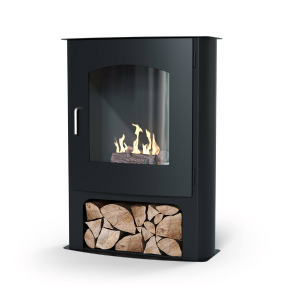
Ahhh. The crackle of an open fire and the warming glow of a real flame. A fireplace can be the making of a living room, but sometimes you need a little inspiration to make a beautiful lounge feature look fantastic.
If you’re here for ideas for hearths for your wood burning stove, you’re in the right place.
In this article, we’ll be exploring what you should know when you create a stunning hearth, along with some strong style ideas that will help elevate your fireplace into the rightful centrepiece of your living room.
1. The materials: what can be used as a hearth for a wood-burning stove?
All wood-burning stoves need a hearth because the body of the furnace is designed to reach extremely high temperatures. You risk a house fire without a hearth!
Your hearth should be made from non-combustible materials. And it should elevate the stove up from the floor of your living room - away from carpets and rugs.
Building regulations define a hearth as a base that safely isolates the combustible appliance from:
- People
- Combustible building fabrics
- Soft furnishings
A hearth needs to separate the open flame from your furnishings and combustibles.
The best materials to use as a hearthstone for a wood-burning stove are:
- Stone or Granite
- Slate
- Glass
- Steel
- Ceramic tiles
All of these materials look really beautiful if you choose wisely.
Try ceramic tiles, stone, or granite if you're looking for something traditional. If you're looking for a more modern-looking hearth, go with glass or steel.
2. How thick does a hearth need to be for a wood stove?
The size and thickness of your hearthstone are dependent upon the size of your stove and the potential heat it's capable of producing.
The general rule of thumb for a hearth on a wood-burning stove that doesn’t raise the temperature of the hearth to over 100ºC are:
- 300mm clearance at the front of the stove
- The hearthstone itself needs to be at least 12mm thick
- Made from non-combustible materials
- It needs to cover a minimum area of 840mm x 840mm
If your stove is likely to heat the hearth to over 100ºC, it should be 250mm thick.
A hearth is made of two elements: the constructional hearth (the area underneath the o stove) and the Visual Warning Area (VWA) (the surface area, often covered with tiles or slate).
The constructional hearth stops whatever is below the stove from igniting. The VWA is often referred to as a "decorative hearth" - basically, it's the stylish bit.
3. Ceramic tiles covering your constructional hearth
There's a vast range of ceramic tiles suitable for hearths. And, of course, ceramic tiles come in an almost infinitive selection of plain, patterned, and textured finishes.
Think about:
- The existing colour scheme in your living room
- The era of your property
- The general aesthetic you’re hoping to achieve
For older houses, you can never go wrong with floral or geometric patterns, such as:

These tiles might look a little garish individually, but it's all about working with the room's existing design (or designing the room around the dominant colours)
For example, the dominant colours in the first two tiles above are based on shades of peach.
Now, you might consider peach a bit of an 80s throwback, and it might be a bit much to paint every wall peach.
But think about the secondary colours on those tiles - in the first, it’s black; in the second, it’s royal blue.
4. Picking out the highlights in tonally dark rooms
Consider a living room with walls this colour:
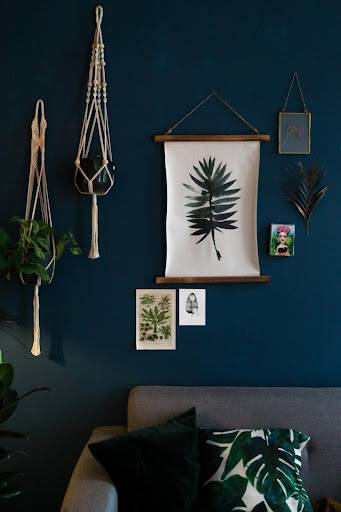
This deep, rich denim blue might feel a little dark for a small room, but designing your space around your hearth tile helps inspire a secondary tone that allows the room to pop.
Above, they’ve used a deep green tone within the cushions and the wall art to bring some earthy groundedness to this lovely space.
But it is all a little dark. Notice, therefore, how the white of the paper literally leaps off the tonal canvas: this is the principle of secondary colour contrasting.
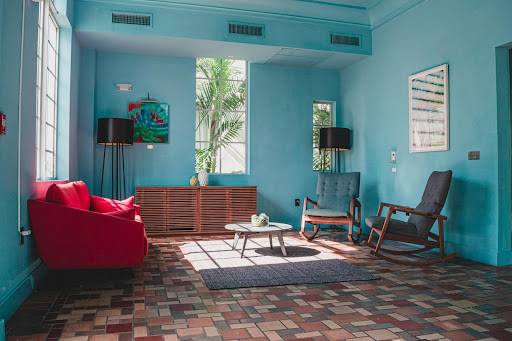
The colour scheme here would work perfectly with our second tile:
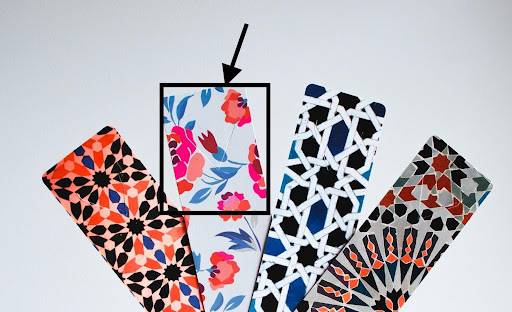
Taking the teal from the plant stems in the tile, it looks bright and cheery in this lovely, spacious living room.
But the stroke of genius is the splash of pink via the sofa and the wall art - bringing some much-needed tonal balance to this living room. Accompanied by the strong, earthy tones of natural wood in the rocking chairs and the sideboard, there’s a deep sense of balance in this lovely teal living room.
OK, there’s no fireplace in that room, but this is all about picking colours from your hearthplace tiles to inspire your palette.
In short: let your chosen tiles for your hearthstone inspire the overall look of your room.
5. Single tones: how to make a wood burner hearth sing
Tiles come in all the colours of the rainbow, and sometimes you just want something more simple than a busy pattern.
And this is where we consider how to embellish your living room with flat colours.
Flat-coloured tiles come in matte, gloss, textured, and high-gloss.
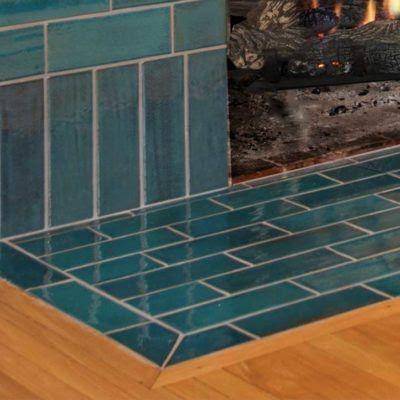
These gloss tiles are a classic choice for a living room hearth. Understated yet striking, gloss tiles add reflective dimension while maintaining that the star of the show remains the log-burning stove itself.
Again, choose a colour that reinforces your room’s tonal palette. This teal against oak is a beautiful contrast.
But remember, you can never go wrong with black for a hearthstone.
6. Blackness all around
Most wood-burning stoves are black. However, you can also get a range of beautiful bioethanol stoves in modern white:
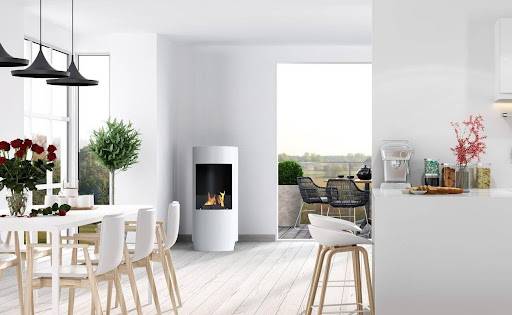
This beautiful modern space uses the pure tonal richness of brilliant white while bringing the earthy tones of reds, pinks, and greens through the houseplants, flowers, and potted shrubs.
Bioethanol fires don’t need a hearth, so it’s possible to place them anywhere in the room.
Corners are great places for bioethanol fireplaces, bringing the energy of the naked flame into any modern space.
However, choosing a black hearthstone helps unify the fireplace aesthetic (especially if your stove is also black). Black works with any colour palette which helps futureproof the design of your living room palette.

7. The power of natural stone
These brick tiles are uber-rustic, bringing an olde-worlde aesthetic into a sparse but homely living room.
But if you’re looking for something a little more sleek, think about how tiling can define the Visible Warning Area, like this:
This is one of the most simple freestanding fireplace hearth ideas, delineating the VWA, while keeping the styling super-simple and striking.
This simple design idea works beautifully in a cottage-style living room.
If you’re looking for a more modern solution, you could consider the greater flexibility of a wall-mounted bioethanol fireplace, like this:
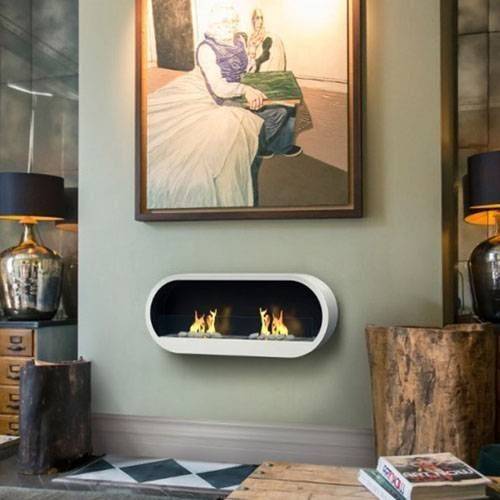
8. Dispense with a hearth altogether
This fantastic modern wood burning stove is elevated from the ground, negating the need for a formal hearthstone. However, the hexagonal floor tiles delineate the Visual Warning Area.
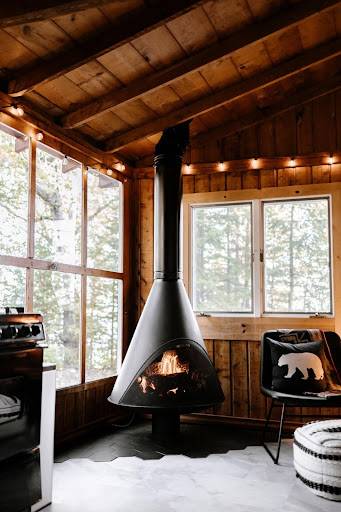
Of course, you still need to comply with building regulations for appropriate space around the front, back, and sides of the fireplace, but this Darth Vadar look is really striking.
This is an excellent example of slick and modern styling in a rustic setting. The sleek lines of the wood-burning stove juxtapose against the rough beauty of natural wood panelling.
Really beautiful.
9. Stone as a hearth material
This wood-burning stove sits in a stunningly rustic inglenook.
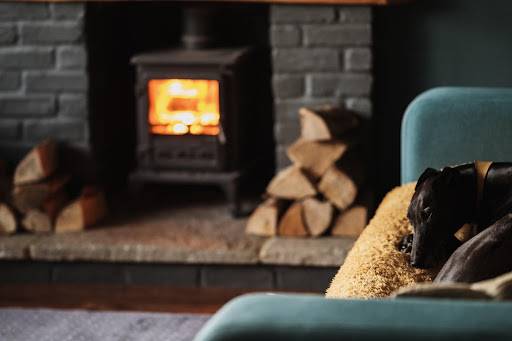
This is one of the most classic fireplace hearth ideas: homely painted brick around the body of the fireplace and a rough-texture stone hearth.
Remember, that since May 2021, all natural wood or combustible fuel you burn in your stove needs to comply with "Ready to Burn” regulations. This dictates the fuel’s moisture levels, which helps reduce air pollution.
If you’re considering how you might minimise your carbon footprint while maintaining the homely glow of a real fire, think about going bioethanol.
Bioethanol is a renewable fuel - a by-product of agricultural plant life. It burns cleanly, without smoke, sparks, or toxic emissions.
10. How do you make a wood burner hearth?
Perhaps the most creative hearth ideas are those you make from scratch yourself.
But:
Before you consider building your own hearth, make sure you’re familiar with the appropriate regulations for your model of wood-burning stove.
Build a wooden frame for your platform; in a similar way you might install garden decking. Map the space out on the floor around the stove with masking tape, so you know that your structure will comply with building regulations.
Once you’ve built the basic frame, cover it with plywood, making sure that the platform beneath the wood burner is reinforced and strong enough to bear the weight of the wood burner stove.
From there, cover the platform with slate or tiles to help create the desired aesthetic.
This video gives you a step-by-step guide on building a wood stove hearth.
Creative Fireplace Hearth Ideas to Embellish Your Living Room
We hope we’ve given you some usable creative ideas that can help you choose how to present your log burner hearth.
Remember, if you’re interested in a more straightforward approach, think about a bioethanol stove that offers way more installation flexibility.
Check out our range of eco-friendly bioethanol fireplaces, offering stylings that match and enhance any living space - from traditional to sleek and modern.

Thanks for reading.





Leave A Reply
Your email address will not be published.